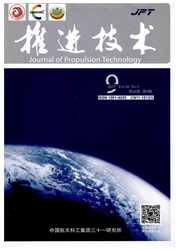

 中文摘要:
中文摘要:
超燃研究地面实验中通过燃烧加热方式获得的高焓气体中通常含有H2O和CO2等污染组分,污染组分可能造成地面实验与实际飞行中燃料着火特性不一致。为了正确评估这两种污染组分对碳氢燃料着火特性的影响,在预加热激波管中研究了H2O和CO2对RP-3航空煤油着火特性的影响效应。根据超燃研究的实际应用需求,以压力为0.05,0.1,0.2MPa和化学当量比为0.5,1条件下RP-3航空煤油在纯净气体中着火特性为基础,分别进行了单独加入4%和25%的H2O,单独加入3%和10%的CO2,以及同时加入15%H2O+10%CO2条件下,污染组分对RP-3航空煤油着火特性影响的对比实验研究。结果表明:0.1MPa时,H2O和CO2单独以及同时存在时对煤油着火基本都没有影响。在0.05和0.2MPa时,H2O对煤油着火具有明显促进作用,CO2对煤油着火产生阻滞作用;当H2O和CO2同时存在且压力为0.05和0.2MPa时,污染组分15%H2O+10%CO2在较大温度范围内表现出对煤油着火的促进作用。从燃烧反应机理和热物理性质的角度对实验结果进行了初步分析。
 英文摘要:
英文摘要:
In ground tests of hypersonic scramjet, the high-enthalpy airstream produced by burning hydro- carbon fuels often contains contaminants H2O and CO2. The contaminants may cause the ignition characteristics of fuels to become discrepant between ground tests and real nights. In order to properly assess the influence of the contaminants on ignition characteristics of hydrocarbon fuels, the effects of H2O and CO2 on ignition characteris- tics of RP-3 aviation kerosene were investigated in a preheated shock tube. To meet the needs of seramjet ground tests based on the ignition delay times of RP-3 aviation kerosene in clean gas, comparative experiments were conducted with clean and vitiated gases. At pressure of 0.05, 0.1 and 0.2MPa, and equivalence ratios of 0.5 and 1, respectively, ignition delay times of kerosene were measured for four cases: (1) clean gas, (2) gas vitiated with 4% and 25% H2O by mole, (3) gas vitiated with 3% and 10% CO2 by mole, and (4) gas vitiated with 15% H2O and 10% CO2 by mole fraction. The experimental results show that water vapor or/and carbon dioxide have almost no effect at pressure of 0.1 MPa. However, at pressure of 0.05MPa and 0.2MPa, respectively, water vapor appears to accelerate the ignition process, whereas carbon dioxide produces an inhibiting effect. At pressure of 0.05MPa and 0.2MPa, an obvious promoting effect appears over a wide temperature range when wa- ter vapor and carbon dioxide exist together. The results were also discussed preliminarily by considering both the combustion reaction mechanism and the thermophysic properties of the test mixtures.
 同期刊论文项目
同期刊论文项目
 同项目期刊论文
同项目期刊论文
 期刊信息
期刊信息
